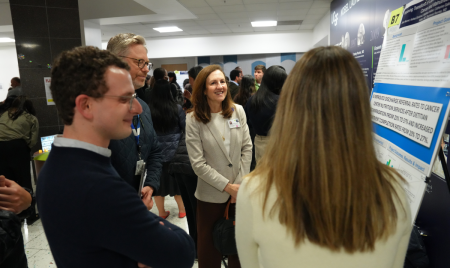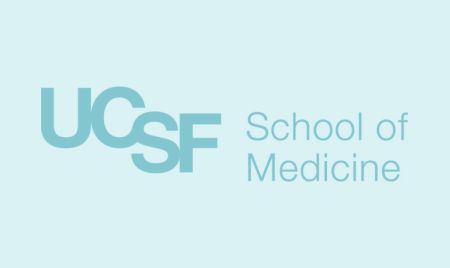Design Thinking Brings Innovation to Health Care and Medical Education

Jyothi Marbin, MD. Photo courtesy of Elisabeth Fall.
‘Design thinking’ was an abstract term to me until I discovered many physicians and educators at UCSF are working in this area. Used to describe an approach to problem solving and prototyping, design thinking is being used at UCSF to improve equity in health care and to train medical students and residents in creative approaches to improving health care systems.
Invited to attend a workshop on the topic at the UCSF Maker’s Lab, I arrived early and surveyed the lab. 3-D printers surrounded us, crayons and markers, tape and play-doh, poster board, sticky notes, and pipe cleaners.
I was attending a workshop for fourth-year Program in Medical Education for the Urban Underserved (PRIME-US) medical students led by Jyothi Marbin, MD, a UCSF pediatrician, Director of the Pediatrics Leadership for the Underserved (PLUS) Residency program, Director of Intern Selection for the Department of Pediatrics, and an Associate Program Director of the Pediatrics Residency Program at UCSF.
Dr. Marbin explained that, when she was named Director of the PLUS residency program in 2015, “I had this great opportunity to think about where PLUS was going, and think about realigning the curriculum. How do we train these leaders in health equity? How do we develop the leadership skills required for solving these particularly complex problems?”
Dr. Marbin has now led several of these workshops, and has trained over 75 UCSF faculty, residents, and medical students in design thinking. At the Maker’s Lab today, Dr. Marbin would share these tools with another dozen students.
Before starting the presentation and interactive workshop activities she planned for us, Dr. Marbin challenged the group, “Continue to think, ‘How might I apply these tools to my community based capstone project, and to addressing health equity in the future’? The challenge of teaching this in the Maker’s Lab, is we only have a couple hours together. We’ll teach you these principles. But in the future, your rapid prototyping should be in the hospital, the clinic, or the community that you’re serving.”
Dr. Marbin explained how design thinking may be a particularly useful tool for addressing issues around health equity and to help tackle “What I call ‘wicked problems’ that span many domains. They are socially complex, multi-causal, require changing people’s behavior, and have no clear solutions. And that’s what health equity is. When kids are going to school hungry, there are financial concerns, transportation issues, politics of the school board, all of these other things involved. There are many stakeholders, and in addition to asking people to change how they do things after many years, there’s often an economic component to consider too.”
Dr. Marbin explained design thinking’s five steps: 1. Empathy 2. Define 3. Ideate 4. Prototype 5. Test.
Hearing Dr. Marbin describe this approach, I felt inspired. Catching my breath for a moment, though, I realized I still didn’t know where to begin. How could I accomplish all of these steps that seemed to be an important way to tackle some of medicine’s thorniest issues of equity in health and health care?
“Grab a partner!” Dr. Marbin continued. “Grab a pen and some paper. I’m giving you a minute. At the same time, each of you must draw the other person! 60 seconds, OK? Ready, go!” Draw the other person? As my head swirled with worries of offending my partner or embarrassing myself, I scribbled away, laughing nervously with him and apologizing profusely.
Suddenly 60 seconds passed and everyone laughed with relief. Students reflected how the time pressure “was liberating,” and “fun.” We agreed with Dr. Marbin that it seemed to “activate a child-like mindset within us”, in which we felt creative, enthusiastic, collaborative, brave.
After more exercises and videos, Dr. Marbin got to the heart of the workshop: “Now it’s time for me to challenge you with a ‘thorny’ question for which you can use design thinking to begin devising solutions.”
Our task was to practice involving ’users’ (in this case, medical students) in designing a solution to help promote wellness in medical school. Dr. Marbin had certainly posed a ‘wicked problem’ to us.
We broke into smaller groups to begin the Empathy step: We identified one student per group to serve as the ’user’ whom we would interview. Dr. Marbin encouraged us, “Invite these end users—in this case your classmate, but in future projects, your patients—to be very involved in the process, in the generation of ideas, in the generation of solutions.”
We first named the problem we were trying to solve using a series of prompts that Dr. Marbin suggested (the ‘Define’ step). Then, in a flurry of sticky notes and markers, we quickly brainstormed wild solutions to the problem, stamped them to a poster board, grouped sticky notes by theme, discussed the ideas, and selected one idea to pursue further.
Now it was time to ‘Prototype’. “The prototyping step is one of the hardest parts of design thinking for us in medicine,” Dr. Marbin said. “We’re so averse to failure.” “So true!” a student chimed in to nods around the room. Dr. Marbin continued, “Try something here; it’s going to fail, and that’s good.”
My group reconvened at the workbench littered with legos and markers. Dr. Marbin’s words echoed in my head. “Build first, then think.”
How could we devise a solution to help promote wellness in medical school? I grabbed a piece of string, and wrapped it around my finger as I scanned the table. Spotting the plastic bacon near the plastic eggs, I announced to the group, “This bacon, here, represents medical student wellness, OK?” Build first, then think, I repeated internally. It’s ok that I don’t know where this is going yet. And as confidently as I could I tied the string around the bacon and plopped my thoughtless creation down between us.
We giggled because it didn’t make sense. Someone grabbed the yellow play-doh and began mashing it together, someone else found a vase and cartoonish pink flowers and fit them together. Our fifteen minutes flew by, and suddenly, we had a plan for a token-based system requiring medical students on their clerkship rotations to take three half days off during each rotation, to be redeemed without advanced planning or explanation needed.
Our lego model demonstrated the calendar system we would implement to help students record their discretionary half-days. Our vase and flowers were a symbol for the research study we would implement concurrently to better understand how students used their discretionary time. The yellow play-doh represented the coin tokens that students would redeem, and the bacon represented our plan to make medical student wellness more visible on the wards, to ourselves, to residents and faculty.
Although the prototype needed further refining, we suddenly had a clear place to begin.
Leaving the Marker’s Lab, Dr. Marbin’s final thoughts stuck with me: “My favorite part of design thinking is the human-centered, collaborative nature of it. I love the rapid prototyping, the invitation to think really big, to think crazy. The gem of the solution can be found in some of those craziest ideas.”









